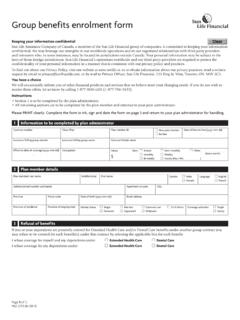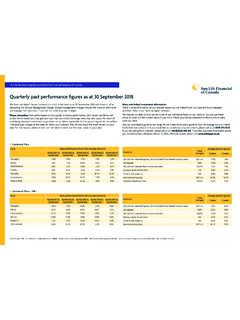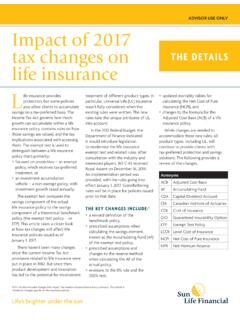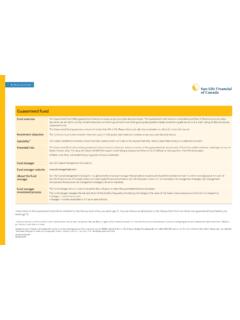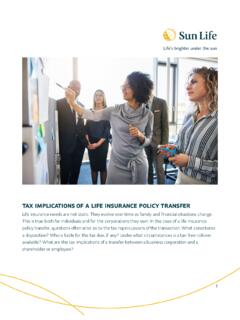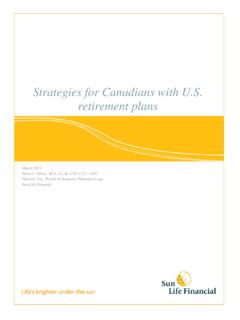Transcription of Strategies for Canadians with U.S. retirement plans
1 June 2017 Stuart L. Dollar, , , CFP , CLU , ChFC , TEP Director, Tax and Insurance Planning Sun Life Financial Strategies for Canadians with retirement plans Sun Life Assurance Company of Canada, 2017. Strategies for Canadians with retirement plans Page 1 Strategies for Canadians with retirement plans canadian citizens who have lived and worked in the United States may own Individual retirement Accounts (IRAs) and qualified retirement plans , such as 401(k) plans . When they return to Canada they may wonder what they should do with the money in these plans . Can they leave their money where it is? Can they move it to a Registered retirement Savings Plan (RRSP)?
2 What are the tax implications? This article explores some of the options and issues surrounding such questions, and discusses how to transfer traditional IRA1 and 401(k) plan money to an RRSP. canadian residents, American citizens and green card holders American citizens and green card holders are subject to tax law even if they don t live in the United States. This article discusses Strategies for canadian citizens and residents. Those Strategies may not be appropriate for citizens or green card holders. Features of IRAs and 401(k) plans IRAs are similar to individual RRSPs. Generally, they aren t sponsored by A plan owner may acquire an IRA in several ways: By contributing to an IRA, just as a canadian contributes to an By transferring their employer-sponsored qualified plan balance to an IRA after terminating from employment (the United States doesn t have the equivalent of a locked-in RRSP).
3 By acquiring some or all of their spouse or common-law partner s IRA because of divorce or death of the spouse or common-law partner. Like RRSPs, IRA balances grow tax deferred, and IRA withdrawals are taxed as income in the year withdrawn. A 401(k) plan closely resembles a defined contribution pension Its name derives from the section of the Internal Revenue Code (IRC) that authorizes it. 401(k) plans are sponsored by employers who want to help their employees save for retirement . 401(k) plans may include employer matching contributions, though this isn t required. Employees may deduct their own contributions from income, and don t have to include employer contributions in income.
4 Contributions grow tax deferred, just as they do in an IRA. There are limits to how much an employee and employer may contribute to a 401(k) plan. Though the limits are different from an IRA, generally ( with minor differences that are beyond the scope of this article), 401(k) plans are subject to the same rules as IRAs. Continuing tax deferral of canadian -owned plans Under the Income Tax Act (ITA) and the Canada United States Income Tax Convention (the Treaty) canadian residents may enjoy continued tax deferral of their IRA, 401(k) plan and Roth IRA5 balances once they return to Canada, just as they would if they were still The deemed disposition and reacquisition rules under ITA section do not apply to IRAs and qualified Continuing tax deferral requires no action or election from a canadian resident who owns an IRA (though not a Roth IRA).
5 ITA clause 56(1)(a)(i)( ) exempts foreign retirement arrangements from tax to the extent that the 1 Throughout this article we will use the term IRA to refer to a traditional IRA, unless otherwise noted. 2 A special type of qualified plan designed for small employers, a Simplified Employee Pension (SEP), uses employee-owned IRAs to which an employer makes contributions. 3 The rules governing who may contribute to an IRA, how much they may contribute, and whether those contributions are deductible (and to what extent), are complex and beyond the scope of this article. 4 401(k) plans are only one type of qualified plan.
6 There are different plans , such as 403(b) and 457(b) plans , but this article will discuss only IRAs and 401(k) plans unless otherwise noted. 5 A Roth IRA is similar to a canadian Tax-Free Savings Account (TFSA). Roth IRA contributions may not be deducted from income, but grow tax-free. As long as the withdrawal rules are obeyed Roth IRA withdrawals are tax-free. Under current law, Roth IRA balances may not be transferred to a TFSA or vice versa. 6 Treaty, Article XVIII. Paragraph 81(1)(r) of the Income Tax Act (ITA) governs tax deferral of IRAs owned by canadian residents. 401(k) plans owned by canadian residents are treated as pension plans and are therefore employee benefit plans under ITA subsection 248(1) (CRA Document 9410515, dated September 28, 1994).
7 As long as an election to defer tax is filed, income isn t recognized from pension plans until a withdrawal is taken. 7 ITA subparagraphs (10)(a)(viii) and (x). These rules deem anyone who becomes a resident of Canada to have disposed of their property just before becoming a resident, and to have reacquired it at fair market value just after becoming a resident. Sun Life Assurance Company of Canada, 2017. Strategies for Canadians with retirement plans Page 2 amount would not, if the taxpayer were resident in the country [ the United States], be subject to income taxation in the country. 8 The Canada Revenue Agency (CRA) has commented on this clause: Where the accrued income in the plan is not taxable under the Act until it is paid out of the plan, there is no benefit to an individual in making the election [under the Treaty to defer tax].
8 In this regard, there would be no need to make the election for a traditional IRA because the Act already provides for a deferral of taxation for these plans . A traditional IRA is characterized as a foreign retirement arrangement for canadian tax purposes. Under clause 56(1)(a)(i)( ) of the Act, an individual is required to include amounts under a foreign retirement arrangement in income only when the amounts are paid out of the Roth IRAs do not meet the definition of foreign retirement arrangement under the ITA and Regulations. Therefore, Canadians who own Roth IRAs must file a one-time election to defer tax on their plan balances. The CRA does not provide a form for making the election, but does provide guidance describing the election s required elements for Roth IRAs.
9 10 Plan owner s name and address, Plan owner s social insurance number and social security number, Name and address of the Roth IRA trustee or plan administrator, Plan account number, Date that the plan was established, Date that the plan owner became a resident of Canada, Balance of the Roth IRA as of December 31, 2008 or as of the date on which the plan owner became a resident of Canada, whichever is later, Amount and date of the first canadian contribution made to the Roth IRA, if any, and A statement to the effect that the plan owner elects to defer canadian taxation under paragraph 7 of Article XVIII of the Treaty for any income accrued in the Roth IRA for all taxation years ending before or after the date of the election, until such time as a canadian contribution is Until recently, the Internal Revenue Service (IRS) provided form 8891 for citizens and residents to elect continued tax deferral for their canadian RRSPs and Registered retirement Income Funds (RRIFs).
10 Recent IRS guidance has rendered the form obsolete for most Non-resident tax treatment of a lump-sum withdrawal from an IRA or 401(k) plan IRA and 401(k) plan lump sum withdrawals are subject to a 30% withholding tax. The IRC imposes this rate on most amounts that a nonresident receives from sources within the United Taxable amounts include items like interest, dividends, salaries and wages, plus a catch-all category other fixed 8 ITA clause 56(1)(a)(i)( ). ITA subsection 248(1) and Income Tax Regulation 6803 define a foreign retirement arrangement as a plan or arrangement to which subsection 408(a), (b) or (h) of the Internal Revenue Code (IRC) applies.
